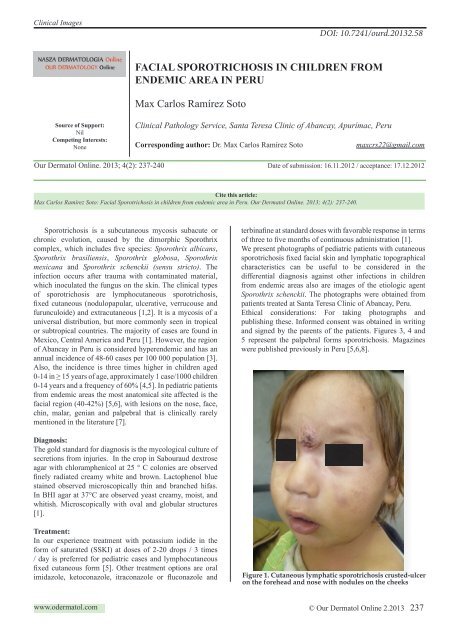download full issue - Our Dermatology Online Journal
download full issue - Our Dermatology Online Journal
download full issue - Our Dermatology Online Journal
You also want an ePaper? Increase the reach of your titles
YUMPU automatically turns print PDFs into web optimized ePapers that Google loves.
Clinical Images<br />
DOI: 10.7241/ourd.20132.58<br />
FACIAL SPOROTRICHOSIS IN CHILDREN FROM<br />
ENDEMIC AREA IN PERU<br />
Max Carlos Ramírez Soto<br />
Source of Support:<br />
Nil<br />
Competing Interests:<br />
None<br />
Clinical Pathology Service, Santa Teresa Clinic of Abancay, Apurímac, Peru<br />
Corresponding author: Dr. Max Carlos Ramírez Soto<br />
maxcrs22@gmail.com<br />
<strong>Our</strong> Dermatol <strong>Online</strong>. 2013; 4(2): 237-240 Date of submission: 16.11.2012 / acceptance: 17.12.2012<br />
Cite this article:<br />
Max Carlos Ramírez Soto: Facial Sporotrichosis in children from endemic area in Peru. <strong>Our</strong> Dermatol <strong>Online</strong>. 2013; 4(2): 237-240.<br />
Sporotrichosis is a subcutaneous mycosis subacute or<br />
chronic evolution, caused by the dimorphic Sporothrix<br />
complex, which includes five species: Sporothrix albicans,<br />
Sporothrix brasiliensis, Sporothrix globosa, Sporothrix<br />
mexicana and Sporothrix schenckii (sensu stricto). The<br />
infection occurs after trauma with contaminated material,<br />
which inoculated the fungus on the skin. The clinical types<br />
of sporotrichosis are lymphocutaneous sporotrichosis,<br />
fixed cutaneous (nodulopapular, ulcerative, verrucouse and<br />
furunculoide) and extracutaneous [1,2]. It is a mycosis of a<br />
universal distribution, but more commonly seen in tropical<br />
or subtropical countries. The majority of cases are found in<br />
Mexico, Central America and Peru [1]. However, the region<br />
of Abancay in Peru is considered hyperendemic and has an<br />
annual incidence of 48-60 cases per 100 000 population [3].<br />
Also, the incidence is three times higher in children aged<br />
0-14 in ≥ 15 years of age, approximately 1 case/1000 children<br />
0-14 years and a frequency of 60% [4,5]. In pediatric patients<br />
from endemic areas the most anatomical site affected is the<br />
facial region (40-42%) [5,6], with lesions on the nose, face,<br />
chin, malar, genian and palpebral that is clinically rarely<br />
mentioned in the literature [7].<br />
terbinafine at standard doses with favorable response in terms<br />
of three to five months of continuous administration [1].<br />
We present photographs of pediatric patients with cutaneous<br />
sporotrichosis fixed facial skin and lymphatic topographical<br />
characteristics can be useful to be considered in the<br />
differential diagnosis against other infections in children<br />
from endemic areas also are images of the etiologic agent<br />
Sporothrix schenckii. The photographs were obtained from<br />
patients treated at Santa Teresa Clinic of Abancay, Peru.<br />
Ethical considerations: For taking photographs and<br />
publishing these. Informed consent was obtained in writing<br />
and signed by the parents of the patients. Figures 3, 4 and<br />
5 represent the palpebral forms sporotrichosis. Magazines<br />
were published previously in Peru [5,6,8].<br />
Diagnosis:<br />
The gold standard for diagnosis is the mycological culture of<br />
secretions from injuries. In the crop in Sabouraud dextrose<br />
agar with chloramphenicol at 25 ° C colonies are observed<br />
finely radiated creamy white and brown. Lactophenol blue<br />
stained observed microscopically thin and branched hifas.<br />
In BHI agar at 37°C are observed yeast creamy, moist, and<br />
whitish. Microscopically with oval and globular structures<br />
[1].<br />
Treatment:<br />
In our experience treatment with potassium iodide in the<br />
form of saturated (SSKI) at doses of 2-20 drops / 3 times<br />
/ day is preferred for pediatric cases and lymphocutaneous<br />
fixed cutaneous form [5]. Other treatment options are oral<br />
imidazole, ketoconazole, itraconazole or fluconazole and<br />
Figure 1. Cutaneous lymphatic sporotrichosis crusted-ulcer<br />
on the forehead and nose with nodules on the cheeks<br />
www.odermatol.com<br />
© <strong>Our</strong> Dermatol <strong>Online</strong> 2.2013 237















